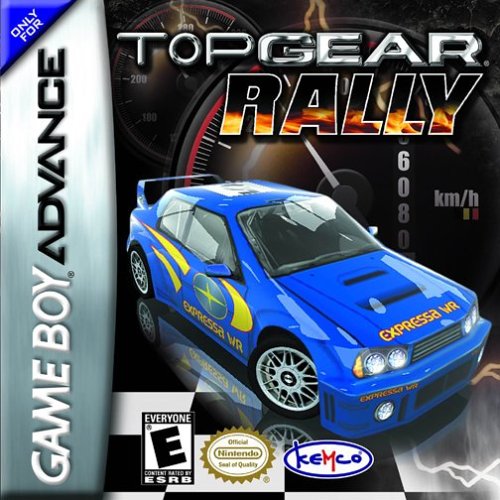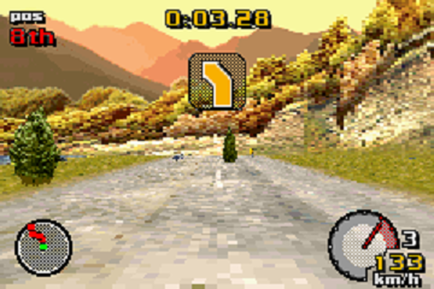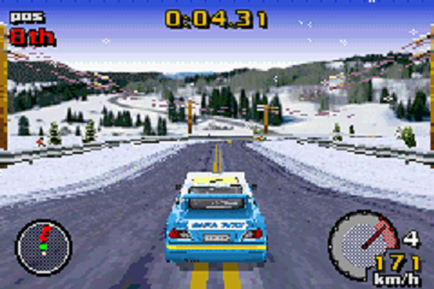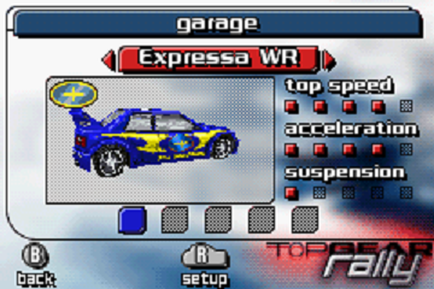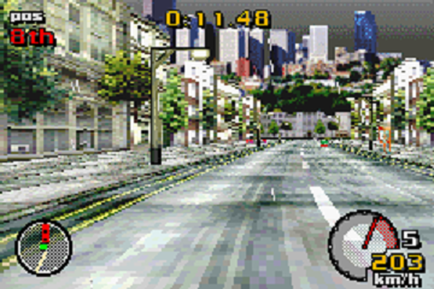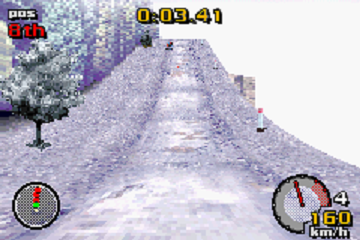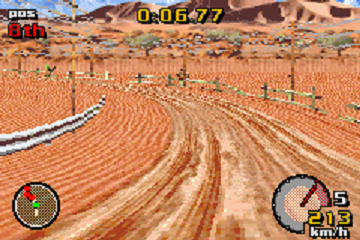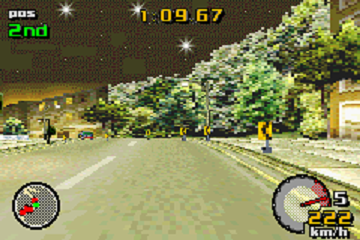TOP GEAR RALLY (GBA)
Kemco’s Top Gear series first made a name for itself back in 1992, when its original outing wowed Super Nintendo gamers with its lightning quick, action-packed races and fantastic split-screen duels. The series has been a mainstay on Nintendo formats ever since, and in 2003, Kemco traded console for handheld and tarmac for rallying as Top Gear Rally landed on the Game Boy Advance. Arriving during a period where technical realism was championed an essential selling point for racing games, TGR made a commendable attempt to work the GBA’s hardware capabilities around to delivering a 3D racer, and whilst there are times when it’s a bit of an eye-sore, it plays surprisingly well.
The Tantalus-developed racer offers up a bevy of championship challenges, with the player competing in rallies consisting of three stages, the goal being simply to finish ahead of most or all of the seven computer-controlled competitors. Predictably enough, you’ll come across a multitude of terrains including gravel and snow, as well as a decent selection of unlicensed though recognisable vehicles based on the various Subaru, Mitsubishi and Lancia cars that had dominated rallying in years prior.
First impressions are a bit leery to say the least. The sludgy opening stage, with its blurry, porridge-pot of shambling pixels and textures, doesn’t inspire great confidence. Nor indeed does the external view, which is tricky to use. Lumbering, delayed animations see the car rotating long after steering, whilst the difficulty of judging depth as you close in on corners and other cars is a serious blight.
Switch to the internal view however, and everything’s suddenly much more assured. It’s not quite thrill-a-minute stuff, but the game handles nicely, and some of the high-speed corners, crests and dips bring to mind the feel of a Ridge Racer in its PlayStation heyday. The difference in car behaviour across various surfaces is appreciable too, and it’s even possible to spin out should you get a little too enthusiastic on the throttle. The A.I. is fairly circumspect and the racing is rarely exciting in the wheel-to-wheel sense, though wrestling with the challenging courses and pleasingly distinguishable cars in large part makes up for it.
Visually, it’s very Jekyll-and-Hyde. Courses typically range between impressive and vomit-inducing. The game engine is very much a technical triumph rather than an aesthetic one, and whilst some might argue that it’s remarkable how such a 3D effect was achieved at all on the Advance, this is little consolation to the average gamer if it’s liable to land you with motion sickness. It isn’t reasonable to expect Tantalus’s portable to rival Colin McRae Rally 3 in the polygon count of course, but at the same time, you wouldn’t necessarily expect it to come off second best to the likes of Mega Drive 3D test-pilot Virtua Racing either. Top Gear Rally undoubtedly looks more comfortable static in screenshots, but on the move, it’s rough, blurry and often heavily-pixelated. In some instances, adding detail makes things worse rather than better, as in some of the urban courses, the dense urban surrounds meld together in a garish mess. Nearly every conceivable graphical frailty is evidenced somewhere along the line; if it’s not the scenery lurching round corners at a disproportionate rate to the roads, it’s trees appearing through the track itself when you hit an incline, and opposition cars jumping between animations, pop-up book style, as you close in on their position – something more generally synonymous with early nineties racers.
Visually, it’s very Jekyll-and-Hyde. Courses typically range between impressive and vomit-inducing. The game engine is very much a technical triumph rather than an aesthetic one, and whilst some might argue that it’s remarkable how such a 3D effect was achieved at all on the Advance, this is little consolation to the average gamer if it’s liable to land you with motion sickness. It isn’t reasonable to expect Tantalus’s portable to rival Colin McRae Rally 3 in the polygon count of course, but at the same time, you wouldn’t necessarily expect it to come off second best to the likes of Mega Drive 3D test-pilot Virtua Racing either. Top Gear Rally undoubtedly looks more comfortable static in screenshots, but on the move, it’s rough, blurry and often heavily-pixelated. In some instances, adding detail makes things worse rather than better, as in some of the urban courses, the dense urban surrounds meld together in a garish mess. Nearly every conceivable graphical frailty is evidenced somewhere along the line; if it’s not the scenery lurching round corners at a disproportionate rate to the roads, it’s trees appearing through the track itself when you hit an incline, and opposition cars jumping between animations, pop-up book style, as you close in on their position – something more generally synonymous with early nineties racers.
Nevertheless, progress to some of the more exotic courses, which travel through snowy landscapes and along coastal roads, and you’ll witness a level of background detail and scenic ambition that’s less evident in the early stages. Cars look really good as well, with clear, colourful and solid bodywork and one or two basic but welcome effects helping matters further. It also sounds good for a GBA racer, with varying engine pitches helping TGR to side-step the dreaded monotone drone of some of its handheld contemporaries, as well as the occasional exhaust spat and some energising title-screen music.
As you’d expect of a Kemco title, it offers a robust challenge, a well-measured difficulty curve, and doesn’t shirk on content either. You’ll have to triumph in more than one hundred races in order to beat the game, and there’s a steady stream of unlockables to foster that all-important sense of progression. There’s a neat training option and time-trials as well, and the wealth of rallies will be enough to keep gamers occupied for weeks.
Despite its litany of struggles with the hardware, Top Gear Rally plays well. Tantalus’s talented programmers somehow managed to devise a serviceable approximation of 3D racing from a handheld that’s clearly not entirely at home with such ambitions. Overlook the rickety graphics and you’ll find a racer that handles well and, as is the way with Top Gear games, offers plenty of bang for your buck. Absorbing and challenging in bite-sized chunks, TGR is in many ways an ideal experience for the handheld environment, even if it’s fair to say it rarely threatens the genre’s frontrunners.
As you’d expect of a Kemco title, it offers a robust challenge, a well-measured difficulty curve, and doesn’t shirk on content either. You’ll have to triumph in more than one hundred races in order to beat the game, and there’s a steady stream of unlockables to foster that all-important sense of progression. There’s a neat training option and time-trials as well, and the wealth of rallies will be enough to keep gamers occupied for weeks.
Despite its litany of struggles with the hardware, Top Gear Rally plays well. Tantalus’s talented programmers somehow managed to devise a serviceable approximation of 3D racing from a handheld that’s clearly not entirely at home with such ambitions. Overlook the rickety graphics and you’ll find a racer that handles well and, as is the way with Top Gear games, offers plenty of bang for your buck. Absorbing and challenging in bite-sized chunks, TGR is in many ways an ideal experience for the handheld environment, even if it’s fair to say it rarely threatens the genre’s frontrunners.
|
VERDICT
Visual: 4/10
Audio: 7/10 Gameplay: 7/10 Longevity: 7/10 OVERALL: 6/10 |
